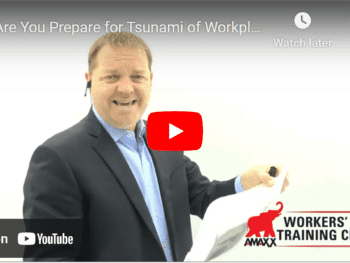Learn More: 2018 Version – Your Ultimate Guide to Mastering Workers’ Comp Costs
Now there are many things in our world today that we just can’t seem to figure out. Some of the most advanced medical treatments, the greatest challenges our country is currently facing, as well as when you’re trying to have a conversation with someone. They just can’t seem to look up from their phone. I can never seem to figure that one out. But while those things are going to continue to be a challenge, there is no mystery in how to drastically reduce worker’s compensation costs and create significantly better outcomes for the injured workers, creating truly a best case scenario for the employer and the employee. In this proven five-step system, this process, these strategies, these tactics, as well as the sequence of how to implement them has been documented in detail in the 2018 version of Your Ultimate Guide to Mastering Worker’s Comp Costs.
No Mystery in How to Control Workers’ Comp Costs
Hello, my name is Michael Stack. I’m the CEO of Amaxx and also the co-author of this comprehensive manual. Now the system, these strategies, these tactics, the sequence was created out of my business partner and co-author’s almost 30-year career in worker’s compensation, implementing this system at some of the largest and recognizable companies in the country. Hundreds of organizations realizing those exact results of drastically reduced costs, significantly better outcomes for their injured workers. This manual was created out of my almost 10-year career in working with Becky and continuing to refine this system and improve it and create more efficiencies and making it more effective. And new just this year out of our medical advisor, Dr. Jacob Lazarovic’s almost 20-year career as Chief Medical Officer at Broadspire, one of the world’s leading third-party administrators. And I can confidently state to you that there is no better source, no more complete source, no more easy to understand source of how to create those outcomes of drastically reduced costs, significantly better outcomes for the injured workers than exists in this 2018 version.
What I want to do today is I want to give you an overview of those five steps, and then I’m going to teach a little lesson about the information and some of the updates that I did in this latest version. Because the last thing that you need is more information. The last thing you need is another book to sit on the shelf. Where this information becomes valuable is when you actually use it, when you learn it, when you implement it. I want to give you a little preview of that today covering two of some of the biggest pain points that employers often will face in worker’s compensation, which is how to avoid litigation and then how to best utilize the independent medical exam for controlling medical costs.
Proven 5 Step System to Reduce Workers’ Comp Costs
Let’s do a real quick overview of these five steps. Now again, this is a sequence. This is a process and this is a system so each one of these steps is going to build upon itself, and the better that you do at step number one is the better that you’ll do at step number four and five.
Step 1: Build Program Foundation
Step number one is to build your program foundation. This includes creating who are these people that are going to be responsible at the employer site? What are their rules? What are their responsibilities? What are the basics of worker’s comp? What is the experience mod? How does that all kind of come together? That’s building that program foundation.
Step 2: Injury Prevention
Injury prevention them. That’s safety and that’s wellness. The least expensive work comp claim is certainly the work comp claim that never happens. That’s what goes into that injury prevention chapter and section within the book.
Step 3: Post-Injury Systems
Post-injury systems. Now this is the bread and butter. This is the engine that’s going to drive those results. This is the area where companies get realized drastic results very quickly because this is post-injury response, this is return to work, this is communication, this is the foundation of the entire process, and if a company can get these elements correct, they’re going to realize significant results very quickly and this could create those reduced costs and create those better outcomes.
Step 4: Claims Management Best Practices / Step 5: Control Medical & Pharmacy Costs
Now if this post-injury system step number three is the engine, then steps number four and five is a higher-octane gasoline that gets poured into that engine because this is leveraging your claims management partners. This is leveraging your vendors. This is leveraging the service providers, your medical providers, your pharmacy benefits management company. And how do you put that all together to help this all work in a very consistent system that runs like a top creating these better outcomes at a significantly reduced cost? That’s what we cover in detail in this comprehensive manual.
How to Avoid Litigation
What I want to do now is I’m going to erase this board and we can dive into some of these tactics, the avoiding litigation and using IMEs. Let’s dive into this topic of avoiding litigation. In the manual itself, we go into much greater detail referencing studies from the work comp research institute, as well as from the Liberty Mutual Research Institute. We have input from a plaintiff attorney and defense attorney in talking about this entire process. But I want you to lock in with me here because this one concept of why injured workers hire attorneys, and avoiding litigation is extraordinarily simple and it comes down to one word, which is fear. The number one reason and the main driver for why injured workers hire attorneys is fear, the fear of the unknown.
And if you could lock in on this concept, understand this concept, have empathy for this concept of putting yourself in the shoes of the injured worker and looking at it from their perspective, then you’re going to be well on your way to this process of mastering worker’s compensation. You’re going to be almost halfway there if you understand the why, then the how to avoid that, the how to improve upon it becomes significantly easier. And all you have to do then if follow the steps of the how that’s documented in the manual itself.
Let’s talk about how you alleviate this fear, and there’s a couple of different things that the injured employees really want to know, and all you have to do is communicate these couple things. One, how am I going to get paid? Two, who’s going to handle my medical and how is that all going to work? Am I going to have to pay a deductible and what doctor am I going to see and am I going to be able to recover? And the last thing, and this is probably one of the most significant, is work. Am I going to be able to continue to work? Am I going to lose my job? Does anyone even want me back at work, and does anyone even care that I got injured? If you could put yourself in these shoes, if you could answer these questions, if you could communicate the answers to these questions for your injured workers, for your employees, you are significantly far down the path to mastering worker’s compensation.
Worker’s comp can be very complex. There’s a lot of layers to it. There’s a lot of different stakeholders involved, but at its core, it’s extraordinarily simple of meeting these basic needs and alleviating this fear within your injured workers. It’s not all sunshine and roses. Your expectation of them is high. You’re running a high integrity program. You’re going to do your best to communicate. Do your best to get them back to work, do your best to set the expectations. Hold up your end of the bargain, and expect them to do the same. And when they don’t, there’s that hard line of integrity that you’re going to then move to potentially deny that claim, move to litigation, prove fraud, etc., etc. We cover a lot of that in the book as well.
Realize Significant Savings on IMEs
So the next thing I want to cover now is the IME process. Let’s talk about the IME, the independent medical exam. This is a vital tactic in medical cost containment best practices. But what we find is that it’s also a significant area of opportunity to create these lower costs and drive these better outcomes because it’s often utilized in the wrong scenarios. IME is a vital piece of medical cost containment, but it also takes a long time for it to be scheduled. It takes a long time for the doctor to generate the report and the injured employee actually has to physically go to the physician’s office. A peer review on the other hand is significantly faster. This is done by a peer review physician at your managed care company. It’s significantly less expensive and can be done often within just a couple of days versus multiple weeks for the IME. Two vital pieces of medical cost containment when they’re used at the right time, so I want to talk about when that is.
Peer Review vs. IME
Let’s talk about peer reviews and when we should be using these. First, if there’s a question of causation. You’re going to have a peer review physician review that information. Next is if you’re finding that you’re not sure whether or not that injured employee can get back to transitional duty, can get back to work, and there’s a little bit of a discrepancy there and you need that medical opinion, peer review is a fantastic solution for that. Along those same lines, if the duration of the injury falls outside of the injury duration guidelines in evidence-based medicine, and you need that medical opinion in order to determine what to do because the adjuster’s not a medical doctor. They’re not medically trained. The employer is not medically trained, and you can’t make that determination of what is appropriate in that scenario. Tremendous option to leverage a peer review.
And the final thing is if you just need a medical opinion on really any other issues within the case. Again, every claim that happens in worker’s compensation needs medical attention to some degree, whether it’s very minor or significant, and many times you need that medical expertise in order to help you make a proper decision on what to do with that claim. So all tremendous times to leverage this peer review option which again is significantly faster and significantly less expensive. Again, IME though is a very vital piece. It’s a vital tactic in medical cost containment when it’s used at the right time.
Let’s talk about these times when that’s needed. If there’s advanced issues in the claim that can’t be handled with a simple peer review, tremendous time for an IME to be leveraged. If you need a formal impairment rating on a case. If it’s going to settlement and you need a formal impairment rating, tremendous time to use an IME. If there’s a legal that’s going to be coming down the pipe and you need that doctor, and then sometimes it’s required by the state law, by the state worker’s compensation boards. So both tremendous tactics. It’s just a matter of deploying them in the right scenarios to drive down those costs and create those better outcomes.
I hope you’ve been able to learn some information on these just real quick sessions that I did in avoiding litigation and then on the IMEs. The key to this entire system, to this entire process, of all the information that’s documented in this comprehensive manual is taking it and implementing it, and when you do that, when you implement this information, when you learn it and you take it one step at a time, you will realize exceptional results.

Workers’ Comp Roundup Blog: https://blog.reduceyourworkerscomp.com/
©2018 Amaxx LLC. All rights reserved under International Copyright Law.
Do not use this information without independent verification. All state laws vary. You should consult with your insurance broker, attorney, or qualified professional.











